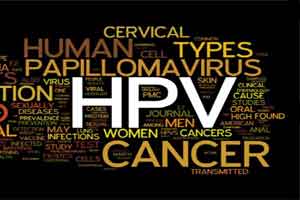- Home
- Editorial
- News
- Practice Guidelines
- Anesthesiology Guidelines
- Cancer Guidelines
- Cardiac Sciences Guidelines
- Critical Care Guidelines
- Dentistry Guidelines
- Dermatology Guidelines
- Diabetes and Endo Guidelines
- Diagnostics Guidelines
- ENT Guidelines
- Featured Practice Guidelines
- Gastroenterology Guidelines
- Geriatrics Guidelines
- Medicine Guidelines
- Nephrology Guidelines
- Neurosciences Guidelines
- Obs and Gynae Guidelines
- Ophthalmology Guidelines
- Orthopaedics Guidelines
- Paediatrics Guidelines
- Psychiatry Guidelines
- Pulmonology Guidelines
- Radiology Guidelines
- Surgery Guidelines
- Urology Guidelines
Low dose radiation after induction chemo highly effective in HPV+ head and neck cancers

The results of the phase II OPTIMA clinical trial presented at the 2018 Multidisciplinary Head and Neck Cancers Symposium in Scottsdale, Arizona indicate that patients with head and neck cancers associated with the human papillomavirus (HPV) who respond to induction chemotherapy initially can receive substantially lower radiation doses safely and effectively. Such patients experienced excellent survival--92 percent were without evidence of recurrence two years after treatment--and had improved functional outcomes with fewer side effects, compared to those who received standard chemoradiation therapy. It implies that Low dose radiation after induction chemo highly effective in HPV+ head and neck cancers.
Compared with HPV?negative head and neck cancer, which typically is caused by smoking and alcohol consumption, HPV-positive disease is more responsive to radiation therapy and chemotherapy and is associated with significantly higher cure rates.
"Head and neck tumors that are caused by HPV respond well to therapy and can be cured reliably," said Tanguy Seiwert, MD, lead author of the study and an assistant professor of medicine at University of Chicago Medicine. "In fact, the effectiveness of combined treatment with radiation and chemotherapy has been so well documented that newer studies such as OPTIMA are focused on selecting patients who can safely receive less treatment."
Although reducing the intensity of cancer treatment offers patients potentially better quality of life, clinicians are careful to use this approach only for patients with a favorable biology for lower-dose therapy. The OPTIMA trial examined response to induction chemotherapy--which is systemic therapy given prior to radiation therapy--as a method to select patients likely to benefit from reduced treatment.
"With our approach of using induction chemotherapy to identify candidates for de-escalated radiation therapy, we achieved excellent treatment outcomes with giving 30 to 35 percent smaller radiation doses, even for patients with advanced nodal stages such as N2C. Patients experienced less toxicity and survival rates exceeded historic data, although more follow-up is needed to confirm these findings," said Dr. Seiwert.
"This degree of de-escalation with high-risk patients is novel, as is selection using induction as the key component to reduce radiation doses and subsequent toxicities to such low levels. In my opinion, treatment for HPV-positive disease should be de-escalated when possible, and induction is an ideal method to identify HPV-related head and neck cancer biology."
Sixty-two patients with HPV-related head and neck cancers were enrolled in OPTIMA. Patients were classified as either low-risk (?T3, ?N2B, ?10 pack-year smoking history) (45% of patients) or high-risk (T4 or ?N2C or >10 pack-years) (55%). The median patient age was 57 years (range 31-85 years), and most patients (85%) were male.
All patients in the trial received three cycles of induction chemotherapy consisting of carboplatin and nab-paclitaxel, and those who responded well received one of two de-escalated treatment regimens: 50 Gray (Gy) of radiation therapy alone (RT50 arm) for low-risk disease, or 45Gy of chemoradiation therapy (CRT45 arm) for high-risk disease. Favorable response to induction chemotherapy was defined as 50 percent or greater reduction in tumor size for high-risk patents and 30 percent or greater reduction for low-risk patients. Patients without a favorable response received regular-dose chemoradiation therapy to 75 Gy. Radiation therapy was delivered over five weeks of 2 Gy daily fractions on the RT50 arm. On the CRT45 and CRT75 arms, treatment consisted of paclitaxel, 5-fluorouracil and hydroxyurea systemic therapy with 1.5 Gy twice-daily radiation every other week. Median follow-up for the study was 22.3 months (range 9-39 months).
All low-risk patients and 32 of the 34 (94%) of the high-risk patients were progression-free at two years following treatment. Two-year overall survival rates were 100 percent for low-risk patients and 97 percent for high-risk patients. One high-risk patient on the CRT45 arm experienced a local recurrence at 11 months following treatment, but the recurrence was treated with salvage surgery.
Side effects from de-escalated therapy were significantly improved compared to standard treatment. Rates of grade 3 or higher mucositis were 16 percent for RT50, 46 percent for CRT45 and 60 percent for CRT75 (p = 0.033). No RT50 patients experienced grade three or higher dermatitis, and the rates were 21 percent for CRT45 and 30 percent for CRT75 (p = 0.056). No RT50 patients experienced long-term dependency on a feeding tube, and the rates were 3.5 percent for CRT45 and 9 percent for CRT75 (p < 0.0001).

Disclaimer: This site is primarily intended for healthcare professionals. Any content/information on this website does not replace the advice of medical and/or health professionals and should not be construed as medical/diagnostic advice/endorsement or prescription. Use of this site is subject to our terms of use, privacy policy, advertisement policy. © 2020 Minerva Medical Treatment Pvt Ltd